Look at all these new books! Today we review five new picture books and find that, as usual, there’s plenty of top-notch stuff being published in Aotearoa New Zealand for our tamariki.
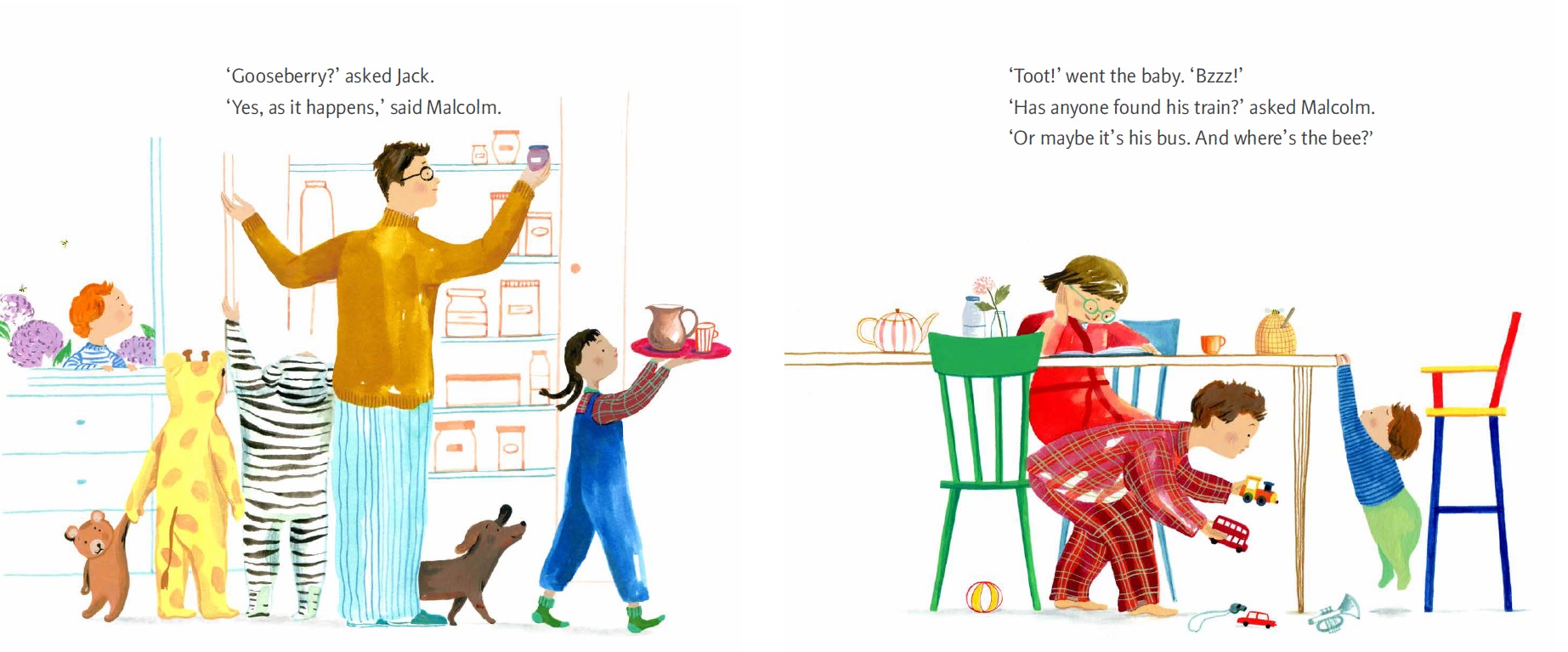
Two or three times on my first reading, I thought I’d accidentally skipped a page of The Longest Breakfast. There was a little jump in the storytelling, a wee surprise in the way something was worded, and then things became clear in a page or two. It’s deliberate, and it’s wonderful. On the second, third and forty-third readings (this has been top of the pops in our house for weeks, now), the unexpected dodges and shifts were one of my favourite aspects of the book.
In an almost filmic way, Jenny Bornholdt tells the story of a family getting up and making breakfast, through little flashes of conversation. There are mysteries – what is the baby asking for repeatedly? – false assumptions, and misunderstandings. There are sudden, realistic changes of perspective, and surprise guests. Funny moments happen when people talk at cross-purposes, or expect people to read their minds. You never quite know what’s coming next. You need to pay attention.
There’s nothing fussy or overcomplicated about the story, it just zig-zags in a fresh, interesting way. I’d love to read more children’s books that play with ever-so-slightly non-linear modes of storytelling and do it so well. Here’s the beginning of one of my favourite exchanges, as a friend from down the street pops up without warning in the open kitchen window:
‘Morning,’ said Toto’s friend Jack.
‘Is there pudding?’
‘Pudding!’ said Malcolm.
‘Yes. Chocolate would be good.’
‘You can’t have pudding for breakfast,’ said Malcolm.
‘You can,’ said Jack.
‘Lucy does.’
‘Who’s Lucy?’
‘My mother’s friend,’ said Jack.
‘She has cake, usually, or a little fruit crumble.’
‘I’m afraid we don’t stretch to pudding for breakfast,’ said Malcolm.
‘Toast will be fine then,’ said Jack.
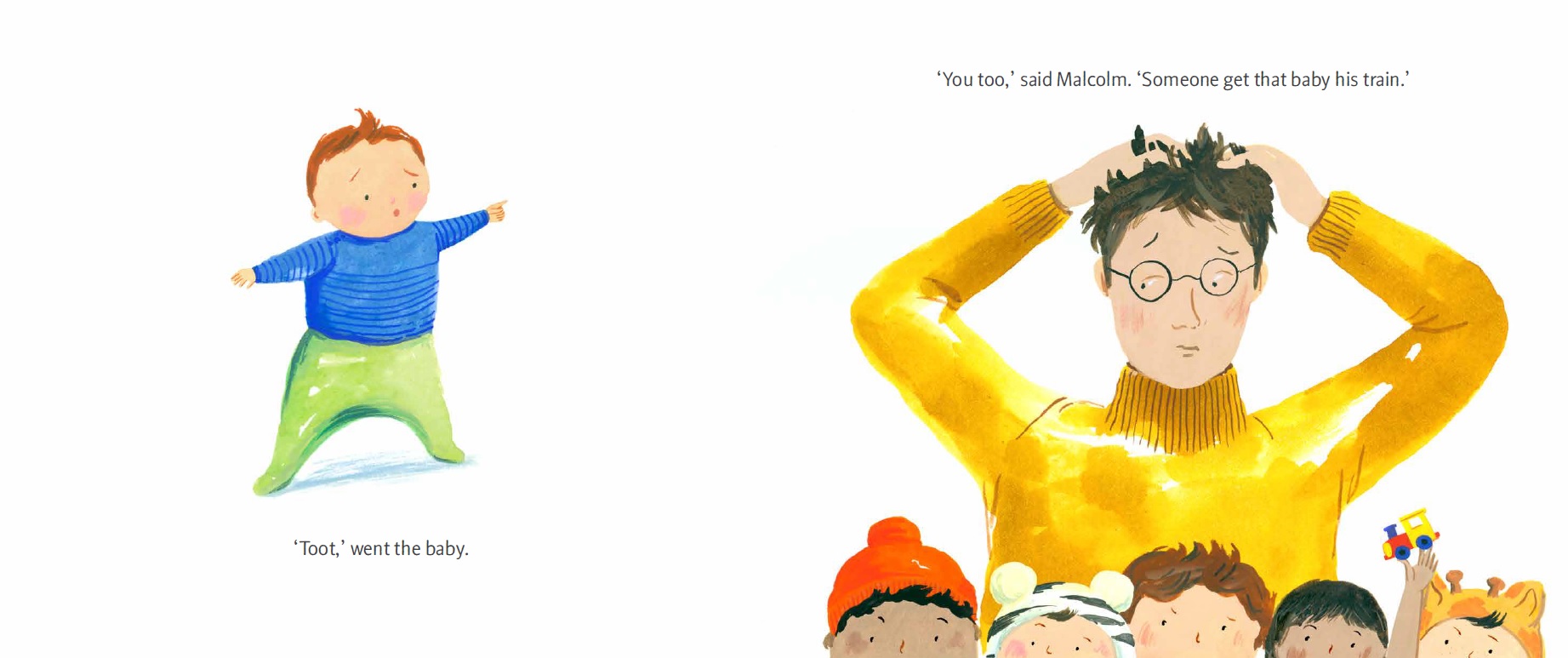
Malcolm doesn’t look like a morning person, poor fellow, and his breakfast service is not going to extend beyond toast, but he navigates the multitude of requests, from eggs and waffles, to pancakes and doughnuts, in good humour.
He’s referred to as ‘Dad’ once, but usually ‘Malcolm,’ which gives a hint that perhaps this is a blended family. No other adult is present, so if you’re looking for sole-parent stories, this fits the bill nicely, though that’s just one interpretation of the circumstances. The family and friends are drawn with a range of physical features, too, so many kids can see someone who looks a bit like them in this story.
The mention of Lucy, whose breakfast habits Jack is familiar with, reads to me as a suggestion that Jack’s mum has a female partner, so I’d add this title to our list from earlier in the year of books reflecting a world where families come in different shapes.
‘Toot and Buzz’ as the book has become known in our house – what does the baby keep asking for? – makes one of the most repetitive and familiar parts of family life fresh and captivating, with delightful characters, bright illustrations and enough to chat about with little ones to last dozens of readings. It’s a winner.
Reviewed by Thalia Kehoe Rowden
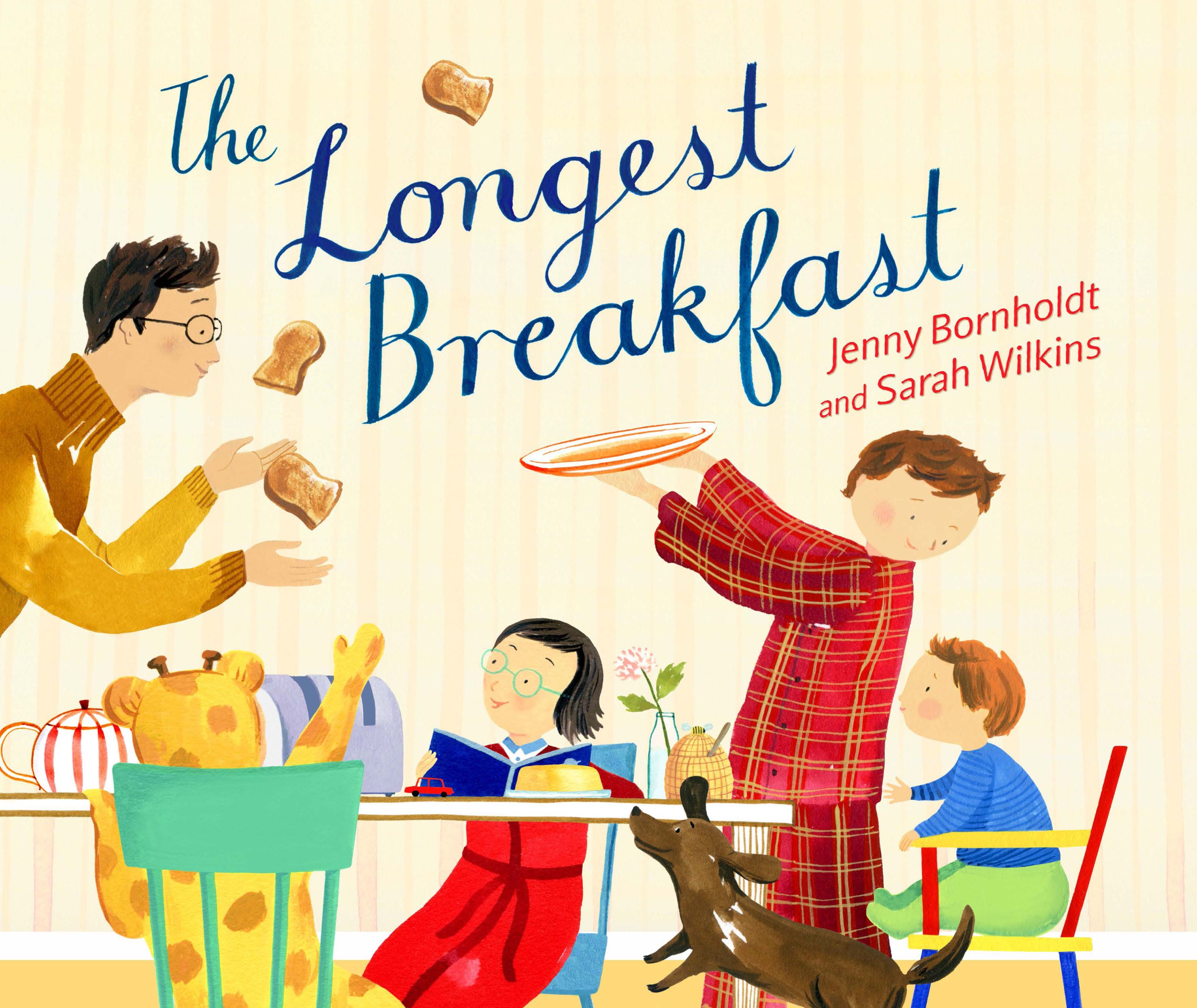
The Longest Breakfast
By Jenny Bornholdt
Illustrated by Sarah Wilkins
Published by Gecko Press
RRP $30.00 (HB)
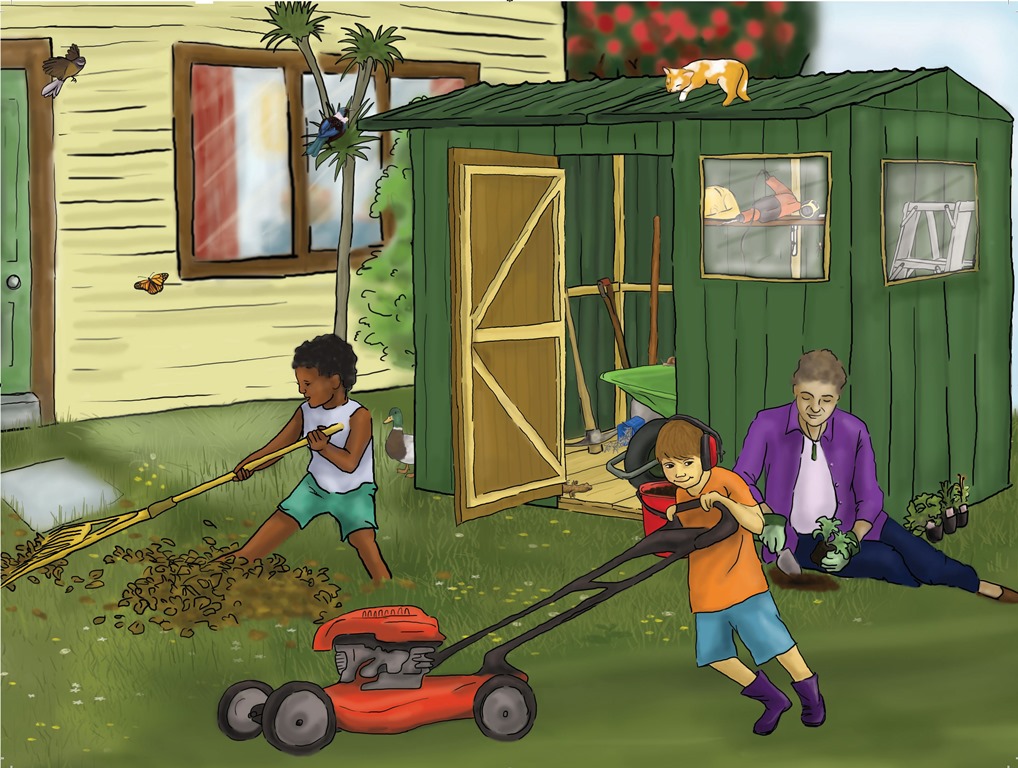
I have mixed feelings about the overall success of this book, but there’s a lot to like.
This story of Nana’s flat-pack shed, languishing unassembled in her back yard until her young grandson and his mate put it together, is beautifully illustrated by Rachel Doragh. There are plenty of nice little details in the pictures, ready to be noticed in successive readings, such as a handwritten letter from Jack to his Nana sitting on her kitchen bench, and the ads in her Yellow Pages.
On each page, as well as the sympathetic characters and their impressively diligent labour, there are creatures and other details to spot. In the corner of each page of text, we are asked ‘Kei hea te…?’ to prompt us to look for something in the picture. ‘Kei hea te ngeru?’ Where is the cat? The animals recur on each page thereafter, so this has proved a really effective way of learning some domestic reo with my children – though I wished the structure for answering the questions had also been provided in te reo, to complete the conversation. There’s also a bilingual counting page and glossary at the back of the book, so you can practise counting piwakawaka and pōtae.
The story is a positive, satisfying one, of kids doing real work, and doing it well. Jacob and Max are a great team, and watching them do all the steps of construction together is a pleasure. There’s a nice moment in the middle of the hard work, where Jacob provides Max with extra grunt in his planing by pushing him from behind. They also use appropriate safety gear and sun protection!
The book is told in rhyming couplets, though, and I wish it had been prose. The rhyming is pretty good, but as Joy Cowley is always telling us, it needs to be perfect, effortless. This is a lovely story, and I think it would have been more interesting in the telling if the author hadn’t confined herself to rhyme.
The proofreading missed a stray full stop, and the book is produced on slightly too thin paper, which is a shame, given the hard work that has gone into it, the quality of the illustrations, and the vivid New Zealand-ness of the whole book. It is otherwise a high-quality publication and will appeal to a wide range of children.
I look forward to seeing more from both the author and the illustrator, and my children and I will keep enjoying watching Nana, Max and Jacob work in a garden full of ti kouka and pōhutukawa.
Reviewed by Thalia Kehoe Rowden
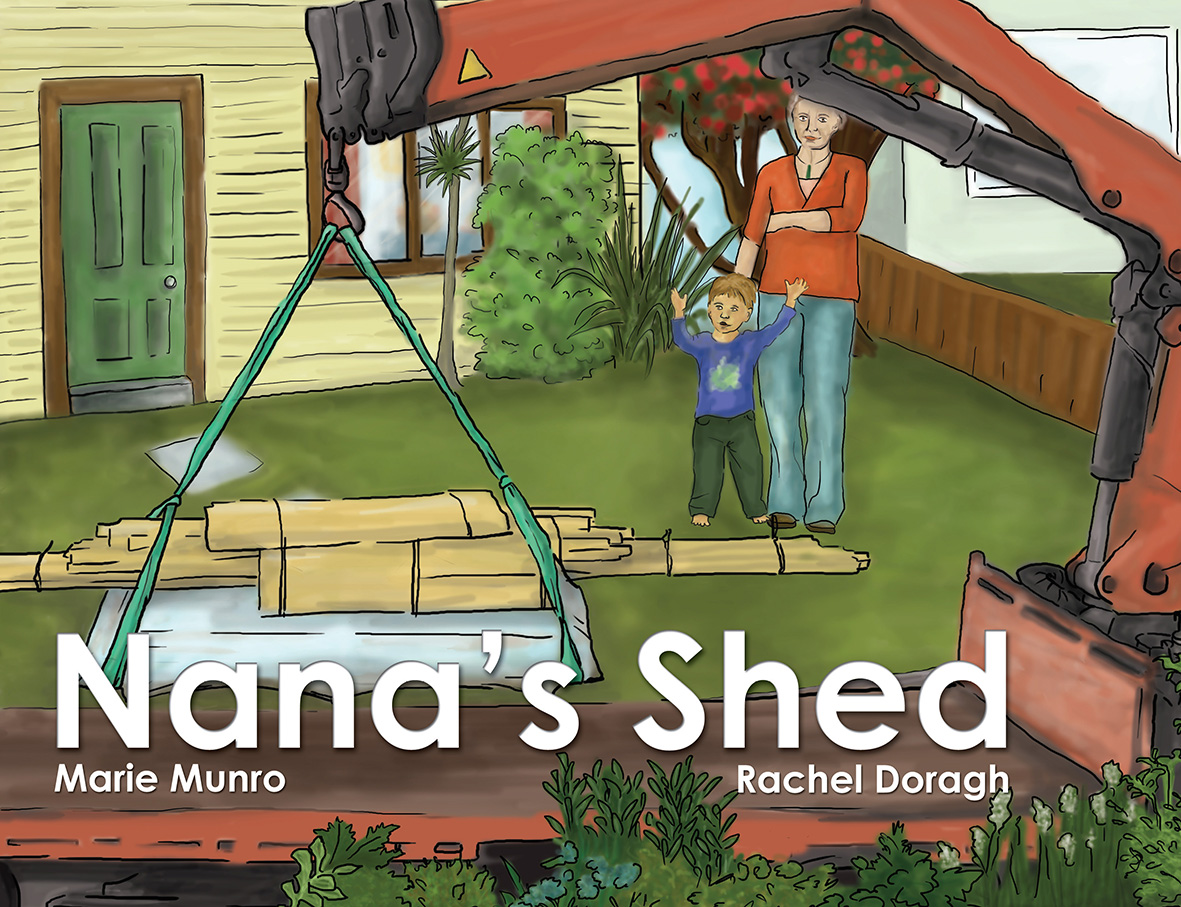
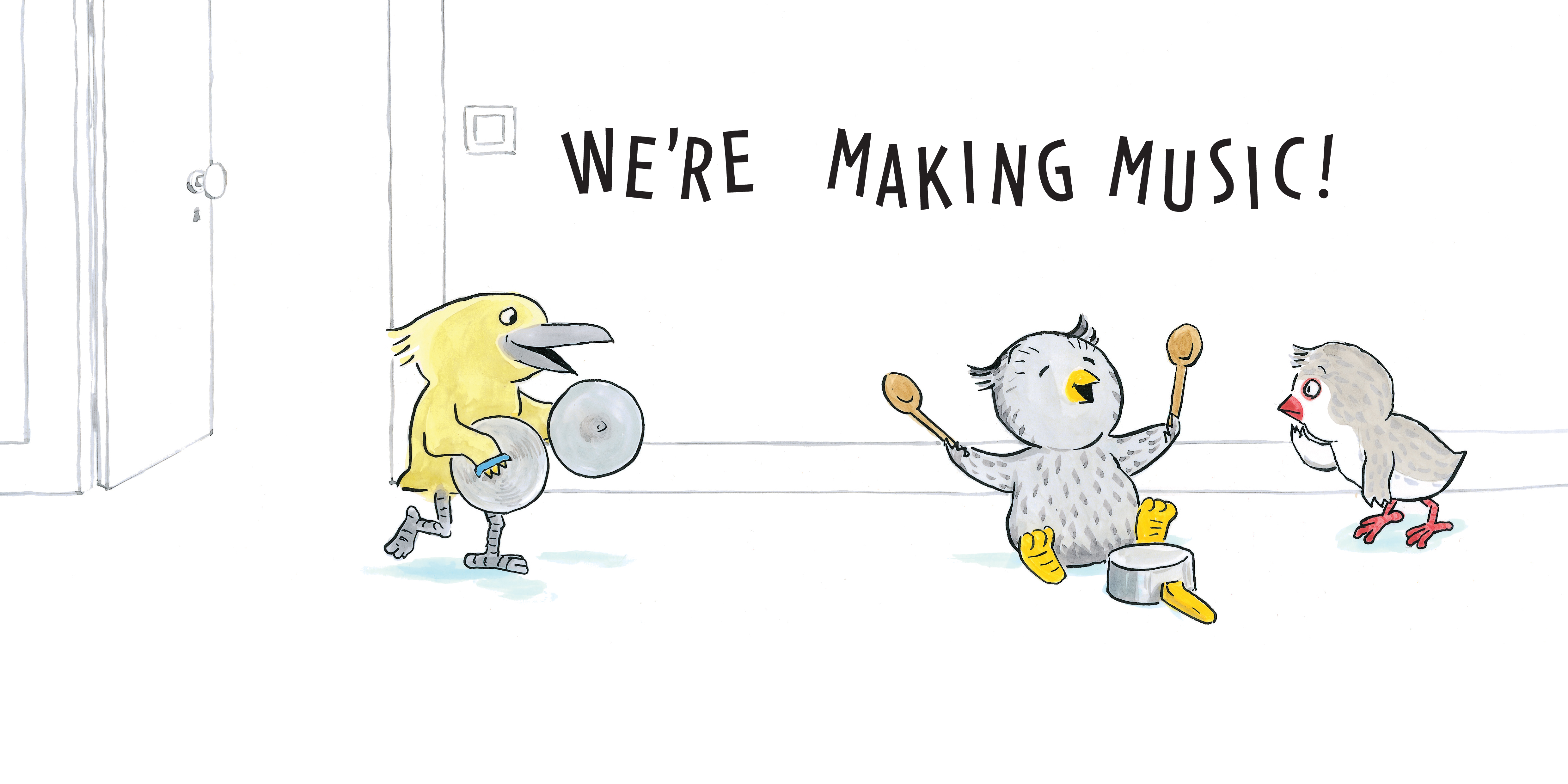
Here’s a fun, raucous board book from Gecko Press, translated from the French.
One little owl (Little Hootie, my son has christened it, since the very sparse text doesn’t give any names) has discovered the joy of banging on a saucepan with wooden spoons: ‘BIM BAM BIM BAM BOOM!’
‘What are you doing?’
‘Can’t you see? I’m making music!’
‘Wait a minute– I’ll be back!’
And off goes a little yellow kingfisher (or Yellow Feather Long Beak in our house) to fetch some pot lids to join the band.
One by one, three more little birds come upon the music-making, repeat the question-and-answer routine and run off to find their own instruments. By the time the fifth has joined in, we have a cacophony of different sounds.
The joy of music-making is apparent on every page, and so is the sorrow when a parent figure is the last to ask ‘What ARE you doing?’ before confiscating the kitchenware. Luckily, the big owl has a surprise consolation prize in mind, and the sad little faces turn into happy ones on the very next page.
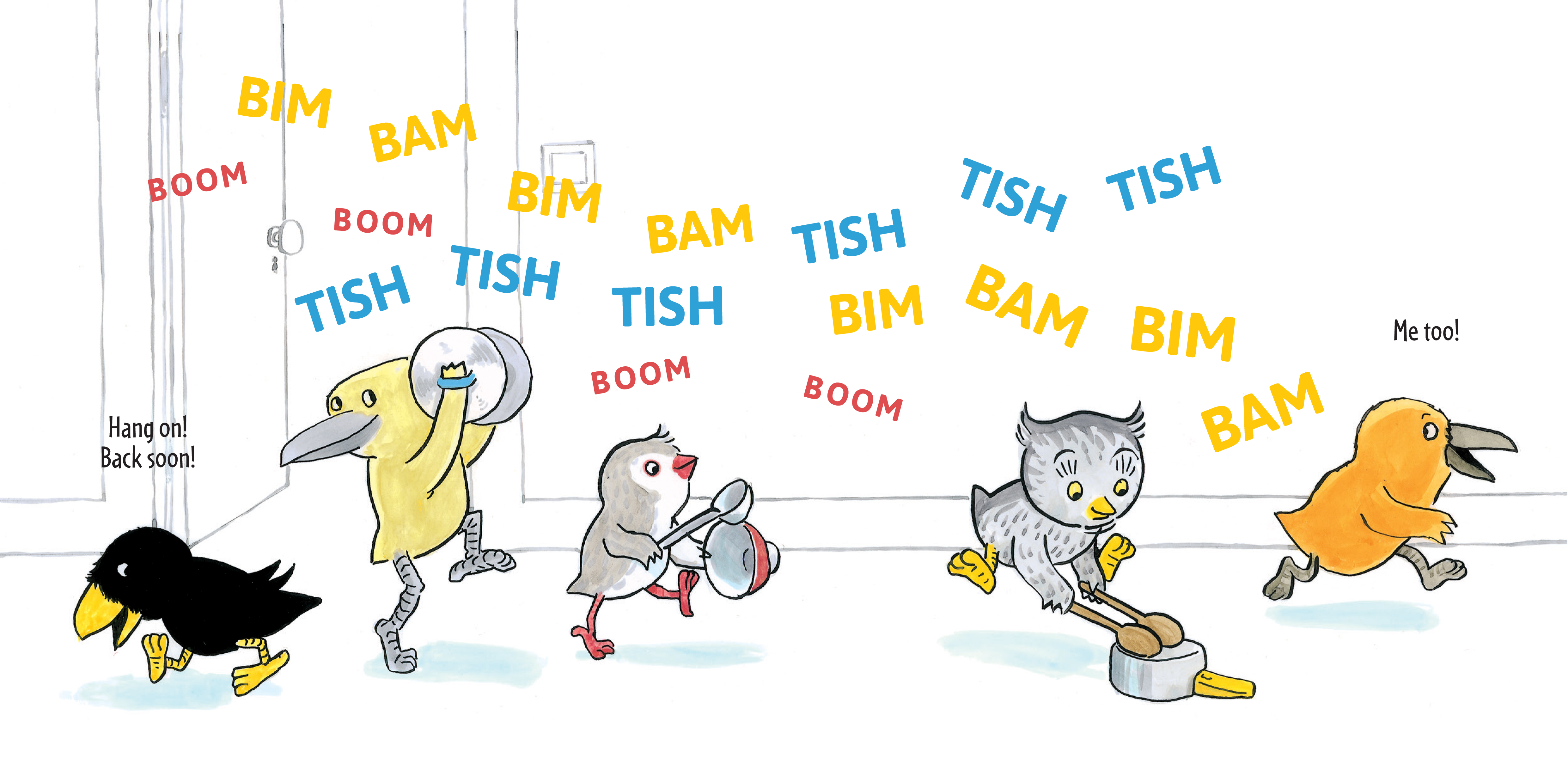
The absolute delight of this book comes from the percussion sounds of each chick’s instrument being represented on the page. On the very first reading, my kids and their Nana quickly turned themselves into a band, with each one taking a different sound effect. The different sounds are written jauntily across the page, and colour-coded, so most toddlers can follow along and make a racket with their adult reader.
The interactions are so simple and engaging that my two-year-old has been spotted ‘reading’ the book to herself, asking on each page, ‘You doing?’ and answering ‘Moozik!’ with the odd ‘TISH TISH’ or ‘BOOM BOOM BOOM’ thrown in.
Most parents will (reluctantly or enthusiastically) get behind a book that encourages all this joyous loudness. I wasn’t such a fan of the admittedly very funny ending, where the little birds move on to painting. Painting the wall with jam. Apparently my use of this plot line as a teachable moment has had some impact, though. When my two-year-old reaches the end, she says, very solemnly, every time, ‘No paint on walls. No. Paint on paper.’
Reviewed by Thalia Kehoe Rowden
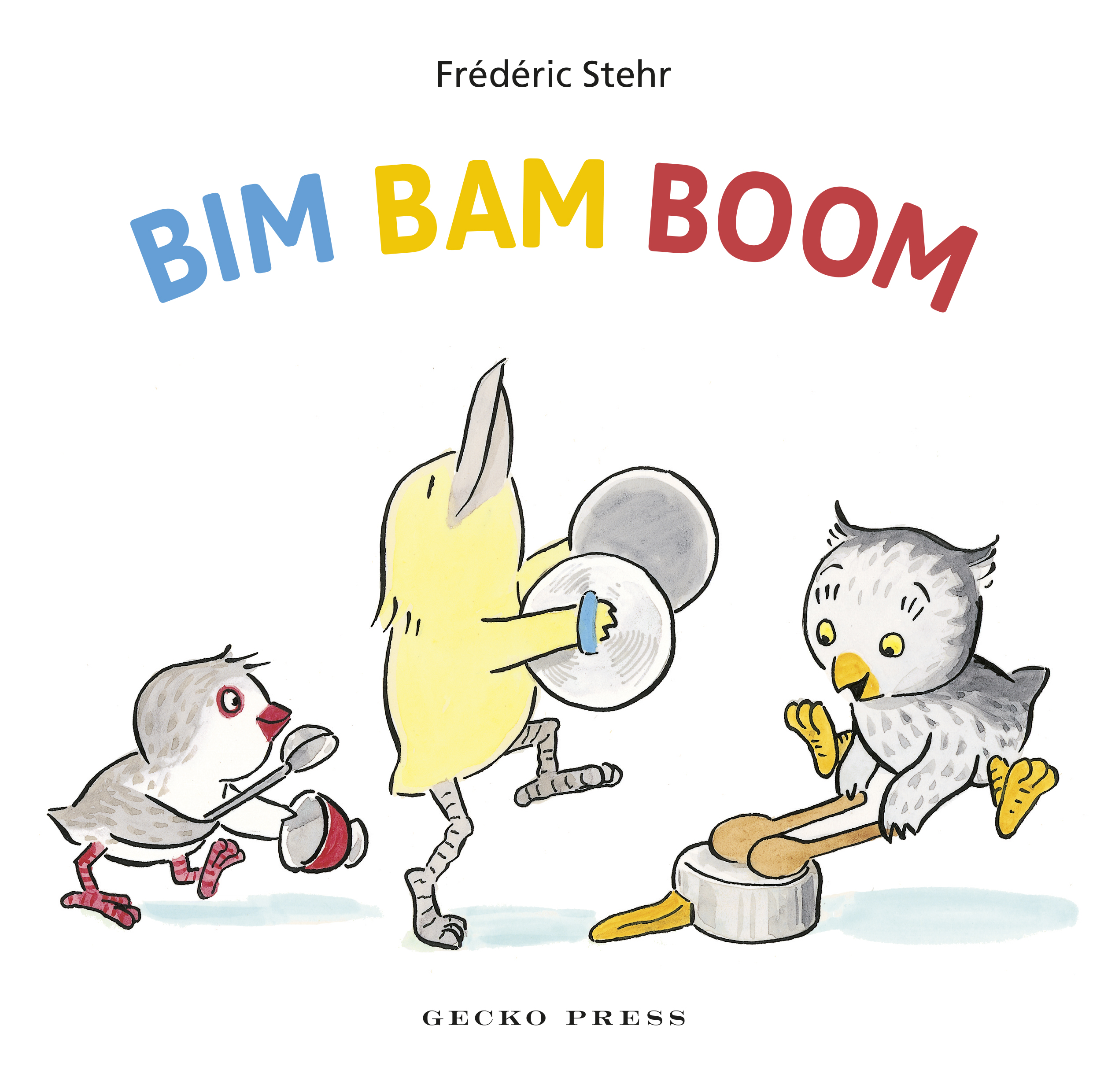
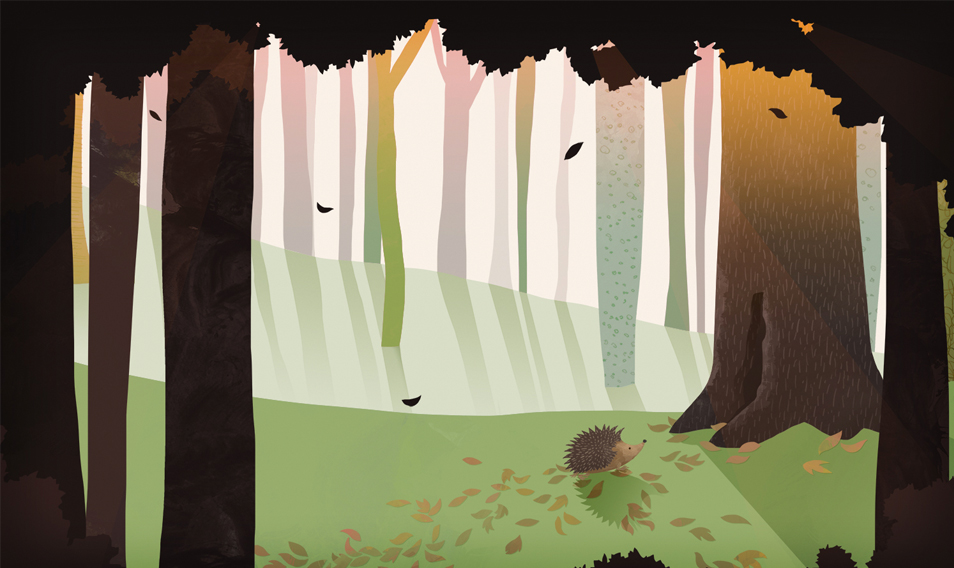
I fell in love with this book a little after having it read aloud to me at its Storylines launch, honouring it as the winner of the 2016 Joy Cowley Award. We featured its illustrators Ali Teo and John O’Reilly on The Sapling in August.
It is for good reason that previous winners of the Joy Cowley Award have gone on to become some of our most beloved authors. I sincerely hope that this happens for Sarah Grundy, as this is a fantastic beginning. Her rhyme and rhythm are near-flawless, reminding me a little of that of Diana Neild, of Piggity-Wiggity fame.
“Humph!” muttered Hedgehog, lifting his snout, “This tree isn’t hollow. It’s got feet sticking out! A cumbersome, orangey, rubbery pair, Attached to a creature asleep in its lair.”
Grundy tells the story well, of a mysterious creature hiding in a hollow tree log. Hedgehog thinks it looks a bit like Goose’s feet, so seeks out Goose to figure it out. Goose admits she doesn’t tend to sleep in trees, and comes for a look. She reckons it might be a Rabbit, and so the story carries on.
At each step, the animals are concerned that whatever it is must be lost and need looking after. There is a lot of compassion in the story, something which may play a good part if you wished to talk to your kids about empathy.
“The poor thing is lost. Together, let’s try to find it a rabbit hole somewhere nearby.”
The build of tension towards the ‘Ar-Chew’ is well-meted, though I did skip a couple of beats thanks to the rhythm changes. Once the animals recover from their surprise, they look everywhere for the strange beast, thinking that it might need help. But it is nowhere to be found!
The illustrations are absolutely integral to the success of this book. The show of the boots, the fur, and more are each well-drawn to not make it too obvious, what exactly the Ar-Chew might be. The idea behind it has had a bit of a zeitgeist moment too, with Julia Donaldson releasing The Great Jumperee just recently – but dare I say it? (I do) – Sarah Grundy and her team do it better.
Get this for your home, your classroom, your library. You will enjoy the looks on everyone’s faces as they try and work out just what the Great Ar-Chew is. Highly recommended.
Reviewed by Sarah Forster
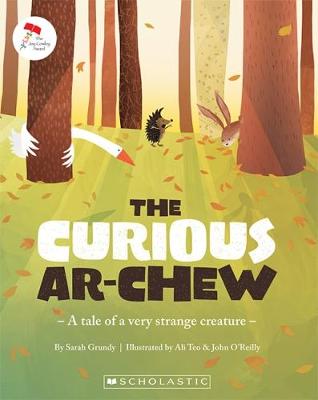
The curious Ar-Chew
By Sarah Grundy
Illustrated by Ali Teo and John O’Reilly
Published by Scholastic NZ
RRP: $18.00
I chose this book for review on The Sapling because it is telling a very different story, based in the reality for the families of those who serve in the New Zealand Defence Forces overseas. It isn’t a crowd-pleaser, and the story arc isn’t completely satisfying, but it is true-to-life, and tells of the strength of a mama while her children’s dad is helping others.
So Special is the story of Oscar, who, as the book opens, is being teased because his dad never comes to his school’s sports day. He gets angry, and lashes out, and is led away by his very understanding teacher Ms Nelisi. We discover that his mama is struggling at home, with his younger sister having become more babyish since his dad has been away, and Oscar too busy dealing with his own feelings to help.
Oscar has a couple of outlets that help him. Firstly, he has a friend who he can confide in, because his friend has been in the same situation (I am imagining a school in Devonport or Waiouru) with his mum having been on postings with the Navy until recently. But as his birthday gets near, he sets his mind on only wanting his dad home for his birthday, and struggles to think of anything else. His dad has sent him cool presents already, but it doesn’t compare to having him home.
The second thing that helps Oscar is his involvement in his school Kapa Haka team, and focusing on his impending big performance helps him to pull through some of his negative emotions.
I’ll be honest and say the story is a little messy, with no resolution of the birthday situation other than that mama says that he needs to stop nagging (then feels bad), and several other under-developed story strands. It does, though, paint a picture of the emotional distress that kids go under when separated for an indistinct period of time from one parent. It also does well in pointing out the type of work our armed forces do – while we are occasionally involved in war, by far the primary purpose of the Army is helping people to live in peace: ‘He’s helping other people who love their kids.’
The illustrations are well-done, if a little flat. The scenes chosen for illustration were well-selected, and for those who can’t yet read, the story is told adequately in the pictures.
My cousin is married to a member of the Australian Army, and has four children aged 6 months – 6 years. I will be sending this book to her and talking with her about it, as it seems like something that will be a useful tool in beginning discussions. My 5-year-old enjoyed it, asking questions throughout.
Recommended, for age 4+, perhaps with a discussion about both the good and the bad sides of what the military does in various countries, something which isn’t tackled due to the focus of the book.
Reviewed by Sarah Forster
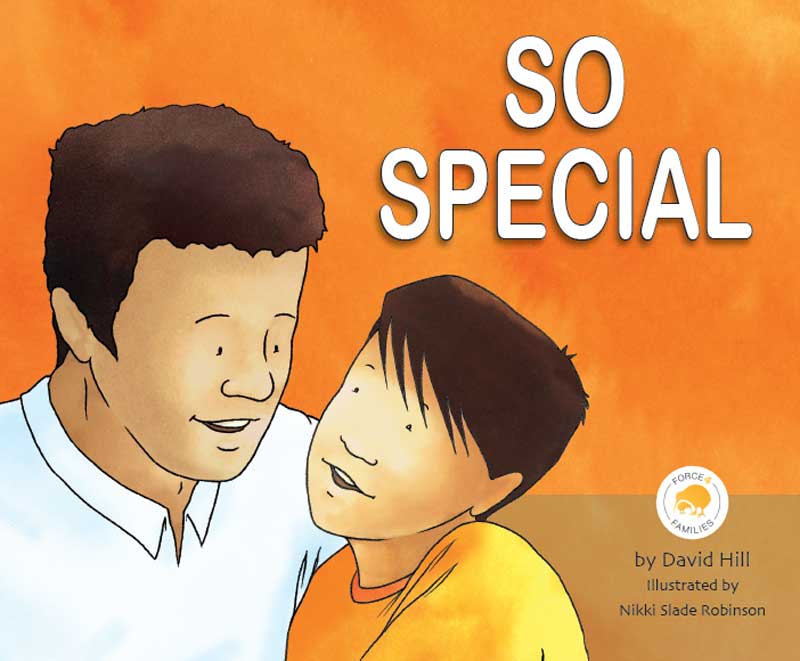
So Special / he tino taonga
By David Hill, illustrated by Nikki Slade Robinson
Published by Duck Creek Press
RRP: $20.00





